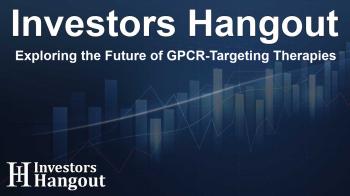Exploring the Future of GPCR-Targeting Therapies

Significant Expansion in the GPCR-Targeting Therapies Market
The GPCR-targeting therapies market is on the brink of substantial growth in the upcoming years. This surge is primarily attributed to a rising number of cancer diagnoses and increased awareness surrounding GPCR-targeting therapies, along with an expanding array of these therapies currently under clinical trials and awaiting approval.
Unpacking the Current Landscape
Research insights indicate that the current treatment practices involving GPCR-targeting therapies have shown promising results, addressing a growing patient population with several critical indications, including peripheral T-cell lymphoma (PTCL), cutaneous T-cell lymphoma (CTCL), migraines, non-alcoholic steatohepatitis (NASH), and more. Each of these conditions is supported by a strong pipeline of ongoing clinical and preclinical activities.
Key Highlights of the Market Report
This market report details notable insights that highlight the potential for GPCR-targeting therapies:
- The market size for these therapies is projected to increase significantly over the next decade.
- Leading therapy companies such as CytoDyn, REMD Biotherapeutics, and Structure Therapeutics are actively involved in developing promising new therapies.
- The driving forces behind this expansion include innovative drug discovery technologies and a deeper understanding of GPCR biology.
Migraine treatment has seen new players enter the market with medications like ZAVZPRET, an innovative small-molecule medication designed to relieve migraine symptoms, demonstrating the therapeutic relevance of GPCRs.
Market Dynamics and Future Prospects
The dynamics shaping the GPCR-targeting therapies market encompass various factors:
Continued advancements in drug development have shifted the focus from conventional therapies to those targeting GPCRs, which are now recognized for their potential across various diseases, notably including cancer and metabolic disorders. With the global demand for targeted treatments growing, pharmaceutical companies are investing significantly in these therapeutic areas, often engaging in strategic partnerships to advance their capabilities.
Moreover, the ongoing research and development efforts have paved the way for next-generation therapies that boast enhanced specificity and reduced side effects. Enhanced pharmacological modalities, such as biased agonists and allosteric modulators, are the newest frontiers in this dynamic field.
Challenges Ahead
Despite the thriving landscape, the market faces notable challenges. The complexity of GPCR signaling pathways coupled with the risk of off-target effects presents hurdles that researchers and developers must navigate. Additionally, regulatory challenges and the high costs associated with drug development necessitate robust planning and innovation.
Outlook on Treatments and Key Players
The outlook for GPCR-targeting therapies remains promising, with several key contenders in the field:
- Leronlimab—a novel treatment showcasing significant effects in combating HIV-related conditions and potential in oncology.
- Volagidemab—targeting glucagon receptors, showing promise in managing diabetes effectively.
- POTELIGEO—a humanized monoclonal antibody that amplifies immune response against cancerous cells.
These companies and their innovative products signify a pivotal move toward transforming the treatment landscape and delivering improved patient outcomes.
Conclusion
As the GPCR-targeting therapies market embarks on this transformative journey toward growth and innovation, the intersection of new treatment modalities and cutting-edge research positions it at the forefront of combating significant healthcare challenges. This burgeoning field holds the promise of enhancing therapeutic options and improving patient lives through ongoing advancements.
Frequently Asked Questions
What are GPCR-targeting therapies?
GPCR-targeting therapies are treatments designed to interact with G protein-coupled receptors, which play a crucial role in various physiological processes and are implicated in numerous diseases, including cancer.
Why is the market for GPCR-targeting therapies expanding?
The market is expanding due to increasing cancer diagnoses, the potential of new drug candidates, and advances in technology that enhance treatment specificity.
Which companies are leading in GPCR-targeting therapy development?
Notable companies include CytoDyn, REMD Biotherapeutics, Structure Therapeutics, and GPCR Therapeutics, all of which are actively developing innovative therapies.
What are some challenges faced by this market?
Challenges include complex signaling pathways, regulatory hurdles, off-target effects, and high development costs, which can complicate treatment approvals.
What role do innovations play in this market's growth?
Innovations in drug discovery and advancements in understanding GPCR biology significantly enhance the potential for creating effective therapies, thus driving market growth.
About The Author
Contact Caleb Price privately here. Or send an email with ATTN: Caleb Price as the subject to contact@investorshangout.com.
About Investors Hangout
Investors Hangout is a leading online stock forum for financial discussion and learning, offering a wide range of free tools and resources. It draws in traders of all levels, who exchange market knowledge, investigate trading tactics, and keep an eye on industry developments in real time. Featuring financial articles, stock message boards, quotes, charts, company profiles, and live news updates. Through cooperative learning and a wealth of informational resources, it helps users from novices creating their first portfolios to experts honing their techniques. Join Investors Hangout today: https://investorshangout.com/
The content of this article is based on factual, publicly available information and does not represent legal, financial, or investment advice. Investors Hangout does not offer financial advice, and the author is not a licensed financial advisor. Consult a qualified advisor before making any financial or investment decisions based on this article. This article should not be considered advice to purchase, sell, or hold any securities or other investments. If any of the material provided here is inaccurate, please contact us for corrections.

